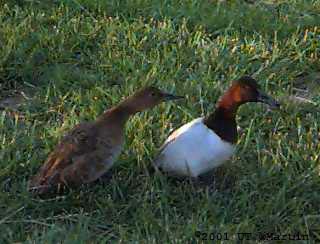

The Canvasback Duck
(Aythya Valisineria)
The Canvasback Duck is a member of the Class Aves and are homeothermous (warm blooded) animals (Van de Graff & Crawley 1998). The Canvasback is a diving duck. The males have a reddish brown head and light gray sides, whereas the females are light brown with a mottled appearance. Their nesting sites are usually in bulky, well concealed areas of the central to western United States. The duck initially nests during the spring or summer, incubates for around 23 to 29 days, and has an average clutch size of 7-10 eggs (UT Martin Univ. 2001). Birds have a close relation to reptiles, and their evolution is thought to be from a basic archosaurian stock of animals living in the Jurassic period around 140 million years ago. The closest living relatives to the Class Aves are the crocodiles and alligators (Kardong 2002).
References:
Chiasson, Robert B. (1959) Laboratory Anatomy of the Pigeon. 2nd Ed. The University of Arizona. WMC. Brown Company Publishers: Dubuque, Iowa.
Kardong, Kenneth V. Ph.D. (2002) Vertebrates- Comparative Anatomy, Function, Evolution. 3rd Ed. McGraw Hill: New York.
University of Tennessee at Martin. Center for Environmental and Conservation Education. (2001) Ducks of the World. www.utm.edu/departments/ed/cece/ducks.shtml
Van de Graaff, Kent M. and John L. Crawley. (1998) A Photographic Atlas for the Zoology Laboratory. 3rd Ed. Morton Publishing Company: Colorado.
Reference for Pictures Only, Not Text:
Pettingill, Olinsewall Jr. (1970) Ornithology in Laboratory and Field. 4th Ed. Burgess Publishing Company: Minneapolis, Minnesota.
Created by Kim Breeden and Sara Viernum